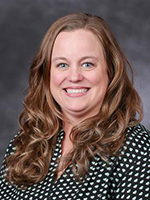New COVID-19 dashboard shows real-time results
UND’s latest COVID-reporting tool keeps public informed on pandemic minute-to-minute

If you click on UND’s COVID-19 dashboard throughout the day, you’ll see the numbers move.
As the North Dakota Department of Health follows up on hundreds of test results each week, it also sends reports to UND. Those statistics, among others, feed the dashboard’s live updates.

“We know that we have cases,” said Jennifer Berger, UND’s director of emergency management. “But we want to be able to mitigate those effects by being able to put those people in quarantine and isolation in a timely matter.”
That same urgency is behind UND’s approach to displaying its COVID-19 numbers. The University’s new dashboard updates in real time as self-reported positives come in from across the campus community, as well as reports from those who are quarantining due to close contact with the virus.
The transparency is part of UND’s assertive and very public approach to combatting the pandemic.
“We need to figure out who those positive cases are, get them isolated and slow the spread,” Berger said. “If we weren’t doing testing, we could just close our eyes and pretend it’s not here. But we are testing, because it is here.”

Executing months of planning
As students returned to UND’s campus for the fall semester, a sharp rise in Grand Forks County COVID-19 cases followed.
“How is this not an outbreak?” asked a member of the University community during last Friday’s Open Forum.

Jed Shivers, UND vice president for finance & operations, acknowledged the increasing numbers, but said that they represent all of the summer’s planning and preparations going into effect.
As of this writing, more than 6,400 tests have been administered on-campus in the days leading up to and starting the fall semester.
“The whole point of what we have been doing to gear up to this time has been to concentrate the testing firepower of the state on our campus,” said Shivers, who’s also the head of UND’s pandemic response.
Berger has been on-site for every one of those testing events since June. She said that testing is what is most important for places such as UND to stay open. Reporting those tests can be even more crucial to a successful response.
The transparency that the dashboard reflects comes from the public’s desire for updated, accurate information, Berger said.

“We’re leading the way in North Dakota in the way we’re displaying this information,” Berger said. “That’s a testament to being on the forefront of emergency management, and having a platform that’s given us the capabilities we need.”
The platform she referenced is Veoci, the University’s virtual emergency operations center. It has been in place for seven years, for use in emergency situations such as floods, blizzards, tornadoes and now COVID-19.
UND Police Chief Eric Plummer, also associate vice president for public safety, had recently arrived to the University at that time and was a proponent of the digital-age upgrade.
“We noted there was significant value in the evolving technology in emergency management,” Plummer told UND Today. “It could allow us the chance to design and execute emergency plans; task responders with assignments; and share information in real-time, with multiple departments, during emergencies and day-to-day operations.”
Accessible from the web, smartphones and other smart devices, and designed to be intuitive and scalable, Veoci’s versatility has been a great asset to UND over the years, Plummer added.

Transparency minute-to-minute
Then when Chief Data Officer Amanda Moske was asked about the possibility of developing a COVID-19 dashboard, she realized Veoci could provide a solution. Moske and her team in University Analytics & Planning often create interactive dashboards for enrollment, admissions and other data, but tallying people directly affected by a viral pandemic is a matter of much higher sensitivity.

Also, given the fluidity of the situation – with students, faculty and staff going in and out of isolation and/or quarantine – the displayed information needed to change just as quickly.
“I felt if we could produce something that was usable and people were comfortable with, and obviously secure the underlying data, I would prefer to use that system,” Moske said. “Because then it could be updated in real time, and there wouldn’t be this issue of manually extracting the data, cleaning it up if needed then uploading it into a product.”
What’s now established is a self-reporting form available through the UND Coronavirus blog. If a member of the UND community either receives a positive test result or is identified as a close contact, he or she fills out a form that feeds into the COVID-19 dashboard, following a manual review.
“When you fill that form out, it goes to either the Office of Student Rights & Responsibilities for students, or to Human Resources for employees,” Moske said.
Either of these offices then reaches out to individuals to verify identities and gather more details to determine next steps, whether to provide hotel spaces or start contact tracing, for example. The data also informs what goes to the dashboard.
“This dashboard provides transparency, and I think people appreciate that,” Moske said. “There are other dashboards at other institutions, and at other levels of government, that are refreshed on a schedule. We’re providing it in real time, so everyone can have an idea of what’s occurring on our campus.”
Berger said the county and state health officials with whom she works are grateful for UND’s efforts.
Though the dashboard site is still going through changes and improvements, given its rapid development, both Berger and Moske are proud of what UND has stood up.
“I think it gives us real clarity into how many cases we have on campus, and how that affects faculty trying to teach,” Berger said. “The public has been asking for this information, so I think we’re doing what the public wants, through sharing.”
“I hope people find it informative, but also that it’s clear in what we’re trying to display,” Moske said. “This has been a stressful time, and I was proud and excited to help out in any way I could.”
Visit the UND Coronavirus blog for the latest information regarding the University’s pandemic response.



